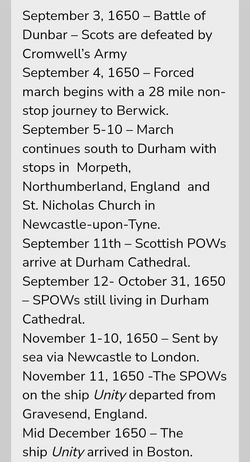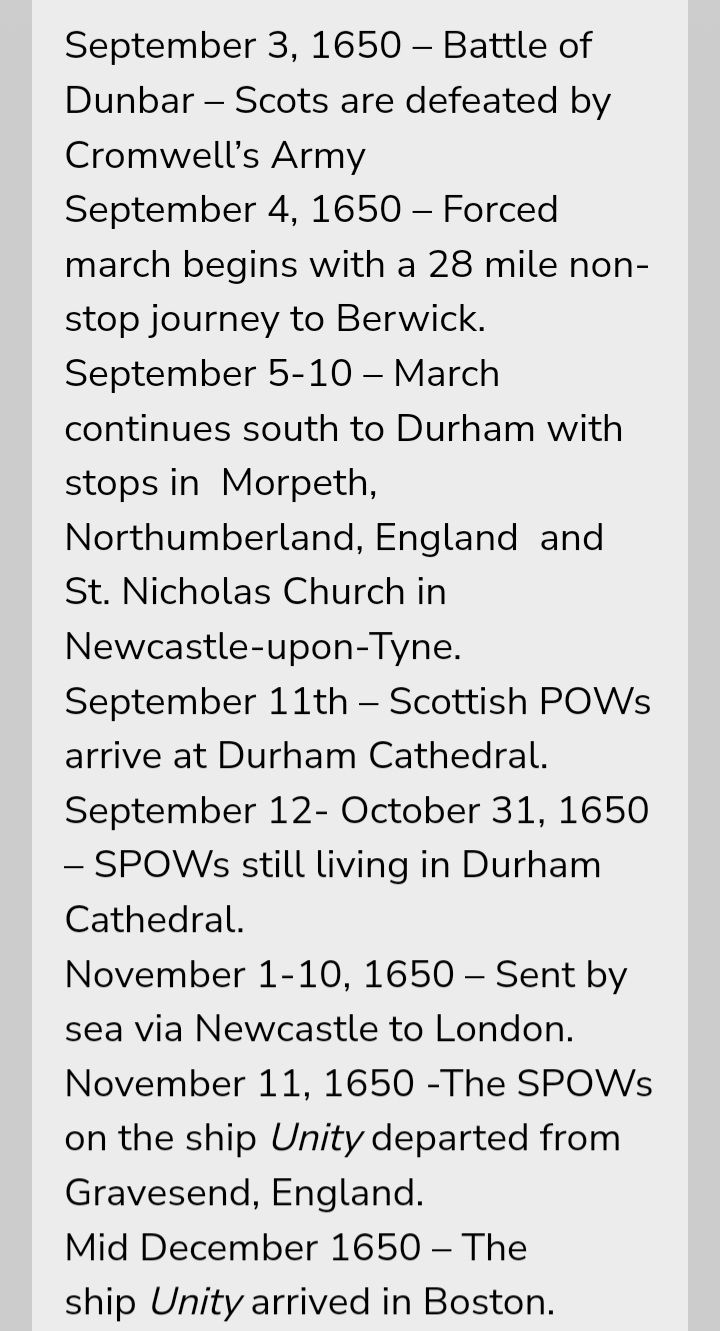They were the parents of eight children: Nicholas, John, William, Elizabeth, James, Margaret, Lemuel, Sarah.
GENEALOGICAL DICTIONARY OF MAINE:
********************************
Elizabeth brought a sizeable dowry into her marriage. Considering the influential position of the Frost family, this was something for a Gael to accomplish in sixteen years, and speaks well of the hardy Highland stock from which he sprang.
********************************
William acquired considerable land in Kittery, his homestead was located at what is now known as 'Gould's Corner in Eliot'. He frequently served on the Grand Jury.
William was buried according to the custom of the time; there having been purchased for the funeral seven gallons of rum and a gallon of wine with 'sugar and spice for same'. There is no lettered stones to mark the final resting place of William and Elizabeth, although they left sufficient estate to have done so.
Province and Court Records of Maine - Maine Historical Society Vol 1 - 1991 p 292
**************************
"Province of Mayn, May 7th 1667, at Yorke, ... Leeftent Charles Frost of Kittery complayns against William x x x alias Smyth of said Town for Bastardy... This Court upon examination ... in concerning the said Gowin alias Smyth in reference unto his charg...do find the said person William Gowin alias Smyth to be the rep x x x ther of that Child layd upon him by Elizabeth Frost"
THE SCOTS IN THE UNITY:
*********************
1650: September 3 - William was a Scot serving under the command of General
David Leslie in the Battle of Dunbar, just south of the Firth of Forth on the east
coast of Scotland. He was one of the 9,000 Scots captured by Oliver Cromwell.
He was among the 5,000 surviving prisoners pushed on a relentless death march from Dunbar to Durham in England. Mortality on the 100 mile march was very high. The Scots were beaten, starved, and those who were too sick to go on were either left behind to die or were butchered on the spot.
Those who reached Durham were handed over to Sir Arthur Heselrig and were kept in the Cathedral, which had been hastily converted to a prison, An average of 30 prisoners died daily due to the squalid and overcrowded conditions of the prison.
September 19 - Plans were made to disperse of these wretched unfortunate men, 150 were selected to be indentured servants' for transport to New England.
November 11 - Augustine Walker, master of the ship 'Unity', set sail for America with this 'human cargo'. It is estimated that it took approximately six weeks to cross the tempestuous wintery conditions of the Atlantic. Therefore, William could not have reached Boston before the end of December 1650. Of those who survived the crossing, sixty were sold to the Lynn Iron Works in Massachusetts, and the remaining, approximately 90, were sold to purchasers willing to pay the price of between £ 20 - £ 30 which was considered as payment for their transportation. As the cost of of an Atlantic passage at the time was about £ 5, the Unity cleared about £ 1,500 on this transaction. These 90 prisoners were then distributed to numerous towns in Massachusetts, Maine, and, New Hampshire.
1651: As a prisoner with a bond term from eight to ten years, William was among the fifteen prisoners sent to the 'Great Works' sawmill at South Berwick in Maine, under the management of Richard Leader. What a cold raw trip it must have been in the disagree- able New England winter, whether by land or sea. Perhaps not to them, though, for it must have been like their beloved Highlands where bleak winters were not unknown.
It is a remarkable trait of stamina that after nearly four months of unmitigated hardship - confinement, disease, and bad food - they made the journey and settled down to lumbering operations at a place that became known as Unity Parish where William worked off the cost of his bondage. For William, a sixteen year old boy, who could survive the Drove of Dunbar, the awful plagues at Durham prison, the horrors of an ocean trip below decks in winter, and the rigors of lumbering along the Atlantic coast - he probably thrived.
As far as is known, this was the first experience that the New England people had in this kind of human traffic, and it is apparent that Reverend Joseph Cotton felt the need of making some explanation for his share in this camouflaged peonage which some of his friends promoted. He referred to this as 'apprentice-ship for a period of seven or eight years', although some served for a considerable longer period.
When these indentured workers were set free, they were destitute, ..........
with compassion, the town of Kittery granted them parcels of land.
They were the parents of eight children: Nicholas, John, William, Elizabeth, James, Margaret, Lemuel, Sarah.
GENEALOGICAL DICTIONARY OF MAINE:
********************************
Elizabeth brought a sizeable dowry into her marriage. Considering the influential position of the Frost family, this was something for a Gael to accomplish in sixteen years, and speaks well of the hardy Highland stock from which he sprang.
********************************
William acquired considerable land in Kittery, his homestead was located at what is now known as 'Gould's Corner in Eliot'. He frequently served on the Grand Jury.
William was buried according to the custom of the time; there having been purchased for the funeral seven gallons of rum and a gallon of wine with 'sugar and spice for same'. There is no lettered stones to mark the final resting place of William and Elizabeth, although they left sufficient estate to have done so.
Province and Court Records of Maine - Maine Historical Society Vol 1 - 1991 p 292
**************************
"Province of Mayn, May 7th 1667, at Yorke, ... Leeftent Charles Frost of Kittery complayns against William x x x alias Smyth of said Town for Bastardy... This Court upon examination ... in concerning the said Gowin alias Smyth in reference unto his charg...do find the said person William Gowin alias Smyth to be the rep x x x ther of that Child layd upon him by Elizabeth Frost"
THE SCOTS IN THE UNITY:
*********************
1650: September 3 - William was a Scot serving under the command of General
David Leslie in the Battle of Dunbar, just south of the Firth of Forth on the east
coast of Scotland. He was one of the 9,000 Scots captured by Oliver Cromwell.
He was among the 5,000 surviving prisoners pushed on a relentless death march from Dunbar to Durham in England. Mortality on the 100 mile march was very high. The Scots were beaten, starved, and those who were too sick to go on were either left behind to die or were butchered on the spot.
Those who reached Durham were handed over to Sir Arthur Heselrig and were kept in the Cathedral, which had been hastily converted to a prison, An average of 30 prisoners died daily due to the squalid and overcrowded conditions of the prison.
September 19 - Plans were made to disperse of these wretched unfortunate men, 150 were selected to be indentured servants' for transport to New England.
November 11 - Augustine Walker, master of the ship 'Unity', set sail for America with this 'human cargo'. It is estimated that it took approximately six weeks to cross the tempestuous wintery conditions of the Atlantic. Therefore, William could not have reached Boston before the end of December 1650. Of those who survived the crossing, sixty were sold to the Lynn Iron Works in Massachusetts, and the remaining, approximately 90, were sold to purchasers willing to pay the price of between £ 20 - £ 30 which was considered as payment for their transportation. As the cost of of an Atlantic passage at the time was about £ 5, the Unity cleared about £ 1,500 on this transaction. These 90 prisoners were then distributed to numerous towns in Massachusetts, Maine, and, New Hampshire.
1651: As a prisoner with a bond term from eight to ten years, William was among the fifteen prisoners sent to the 'Great Works' sawmill at South Berwick in Maine, under the management of Richard Leader. What a cold raw trip it must have been in the disagree- able New England winter, whether by land or sea. Perhaps not to them, though, for it must have been like their beloved Highlands where bleak winters were not unknown.
It is a remarkable trait of stamina that after nearly four months of unmitigated hardship - confinement, disease, and bad food - they made the journey and settled down to lumbering operations at a place that became known as Unity Parish where William worked off the cost of his bondage. For William, a sixteen year old boy, who could survive the Drove of Dunbar, the awful plagues at Durham prison, the horrors of an ocean trip below decks in winter, and the rigors of lumbering along the Atlantic coast - he probably thrived.
As far as is known, this was the first experience that the New England people had in this kind of human traffic, and it is apparent that Reverend Joseph Cotton felt the need of making some explanation for his share in this camouflaged peonage which some of his friends promoted. He referred to this as 'apprentice-ship for a period of seven or eight years', although some served for a considerable longer period.
When these indentured workers were set free, they were destitute, ..........
with compassion, the town of Kittery granted them parcels of land.
Gravesite Details
What is now known as Shapleigh grave yard is where the earliest Gowens were buried. Here are, at least 33 unmarked graves. Here is probably buried William GOWEN in 1686 and his wife, Elizabeth FROST; together with their descendants.




